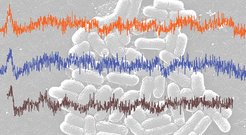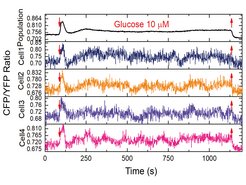Fluctuations by the minute
Measurements in single living bacterial cells reveal large periodic fluctuations of bacterial metabolism
Using single-cell FRET microscopy, researchers at the Max Planck Institute for Terrestrial Microbiology have found large fluctuations in the bacterial sugar degradation pathway that cannot be detected at the whole population level. Because the observed fluctuations occur on a time scale of minutes, they could have major implications for the physiology of E. coli by affecting other cellular processes.

One of the most important properties of a cell is its ability to respond appropriately to changes in its environment. When measured for populations of cells, such as a bacterial culture, these responses appear to be deterministic, meaning that a particular environmental challenge results in a well-defined response. However, molecular interactions within the cytoplasm of living cells are subject to the laws of stochasticity, which can lead to dynamic fluctuations in the activities of cellular networks and variability in the behaviour of individual cells.
In the case of gene expression, the mechanisms and consequences of such biochemical “noise” are relatively well known, especially in microorganisms, since the introduction of fluorescent proteins has made it possible to visualize it at the level of individual cells. In contrast, the impact of background noise on protein networks, such as the metabolic network, is poorly understood, although it is thought to be similarly influential to that of gene expression. One reason for this is the difficulty of measuring the activities of protein networks in single cells with sufficient temporal resolution and sensitivity.
A team of researchers at the Max Planck Institute for Terrestrial Microbiology led by Prof. Dr. Victor Sourjik has now succeeded in quantifying metabolic activity at the level of individual bacterial cells. In the study, published in the journal Nature Communications, the researchers used FRET single-cell fluorescence microscopy to observe the behaviour of E. coli cells exposed to a stepwise supply of different sugars. It was found that this stimulation leads to large periodic fluctuations in the concentration of the key metabolite pyruvate in individual cells. Consistent with these experimental observations, mathematical modelling of E. coli metabolism by the group of Prof. Dr. Hannes Link (now at the University of Tübingen) showed that regulatory feedbacks within the metabolic network make it prone to such oscillatory behaviour.

Strikingly, although the fluctuations were strong and persistent, they could only be detected at the level of individual cells. In contrast, when metabolic activity is measured at the level of the entire bacterial population, the effect is much less pronounced because fluctuations in individual cells are not synchronous and therefore average out. While these fluctuations in sugar degradation by E. coli are similar to glycolytic oscillations previously reported in yeast and mammalian cells, their mechanism and impact may be different.
"In fact, our data suggest that these fluctuations influence other cellular processes and lead to temporal heterogeneity of cellular states within a population," explains Shuangyu Bi, first author of the study, who has meanwhile started her own group at Shandong University in China. "Thus, the study provides important basic data for further research on the temporal dynamics of protein networks in bacteria."
Victor Sourjik, Director at the Max Planck Institute for Terrestrial Microbiology, adds: "It is remarkable that the observed fluctuations occur on a minute scale. This is comparable to the timing of many regulatory processes in bacteria. Therefore, in dynamic environments such as the mammalian gut, they may have important implications for E. coli physiology. However, more work is needed to understand the mechanisms and consequences of oscillatory dynamics in bacterial metabolism.“












